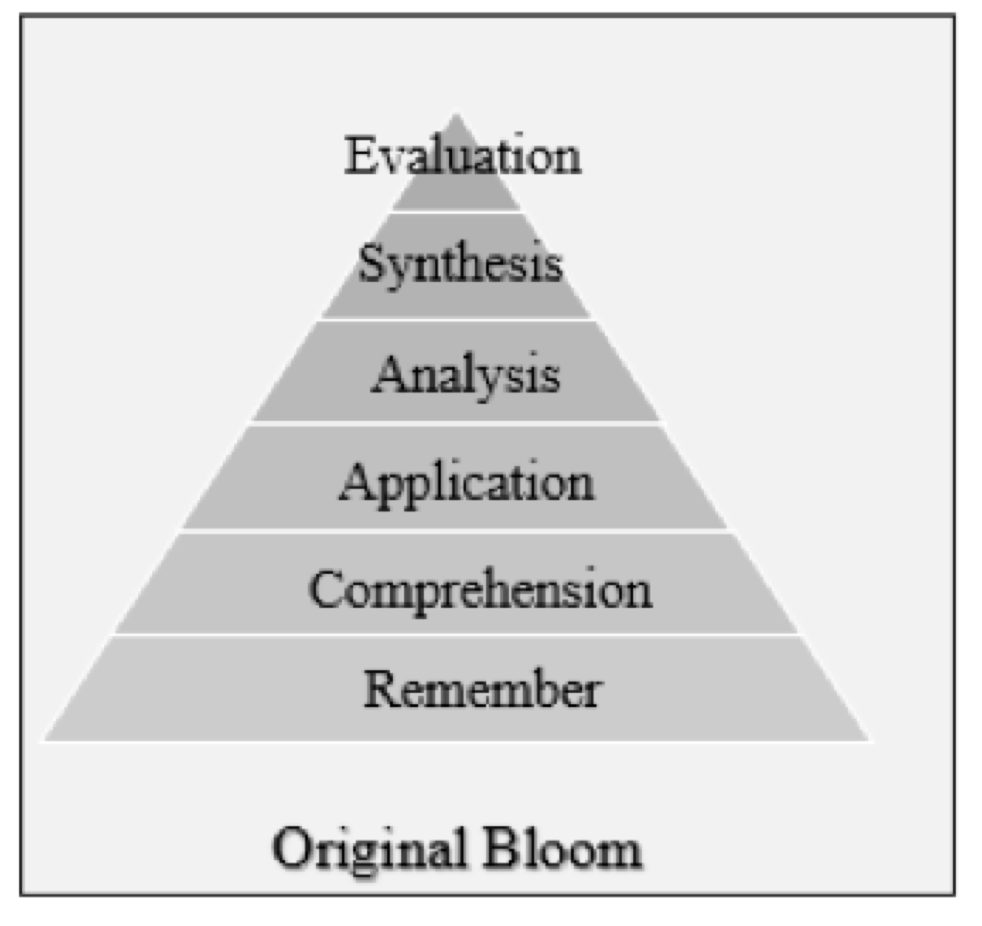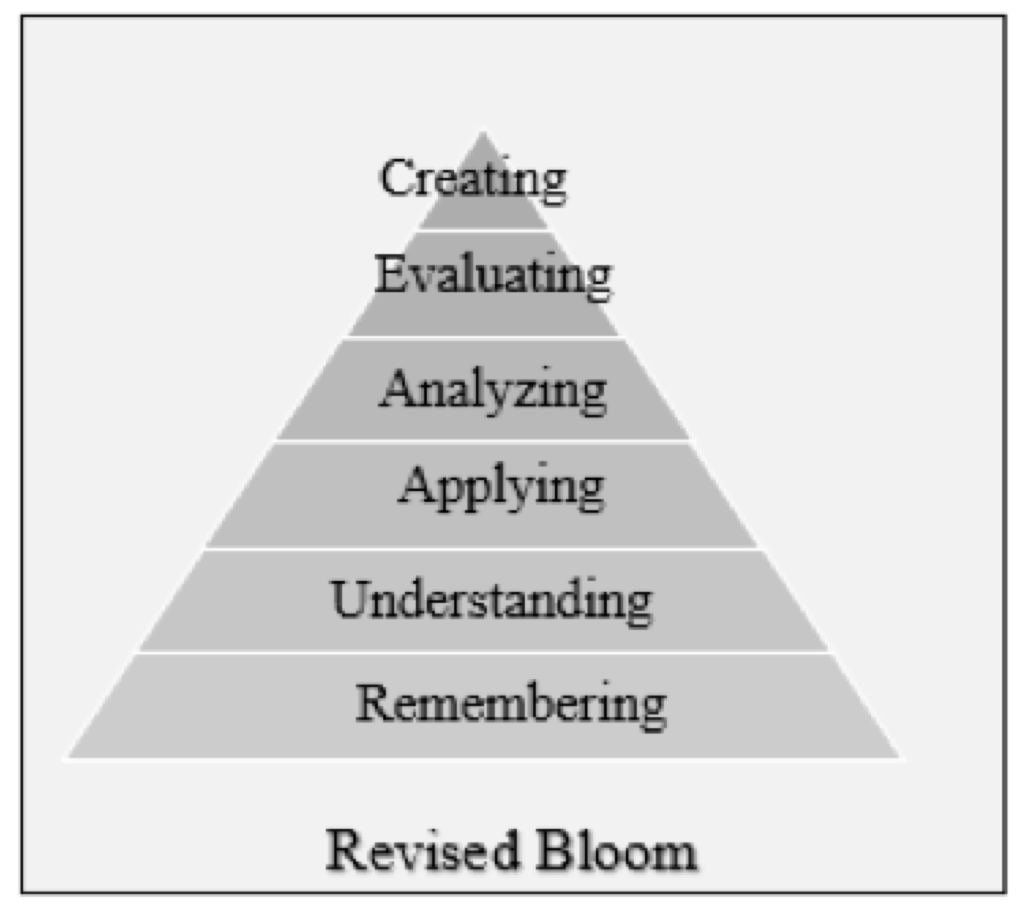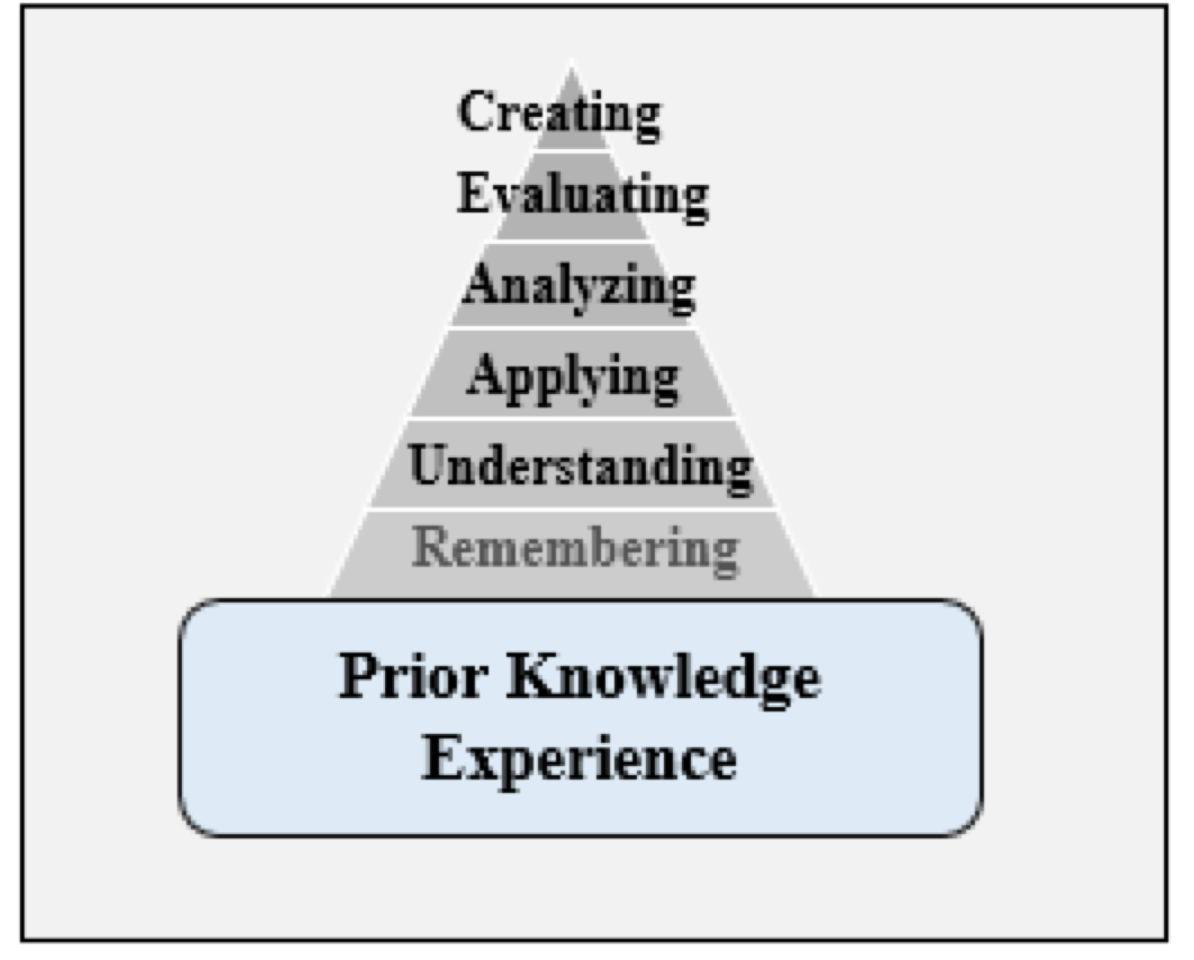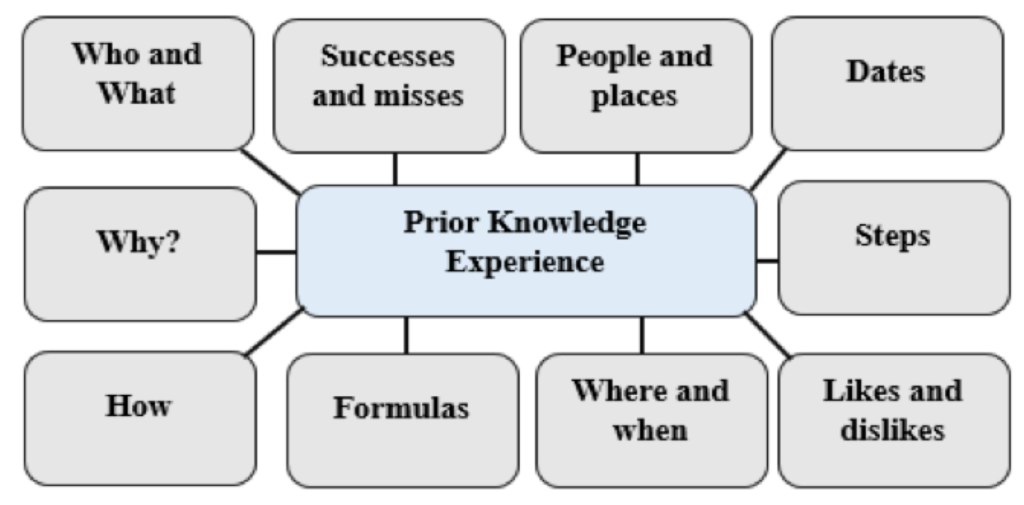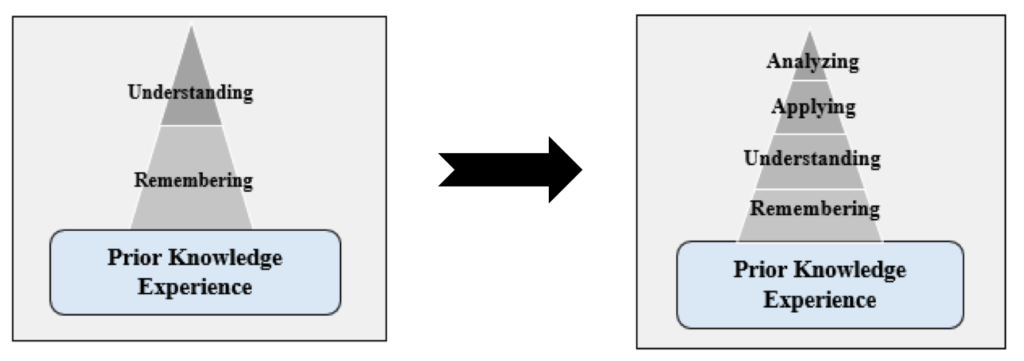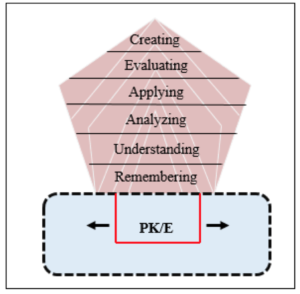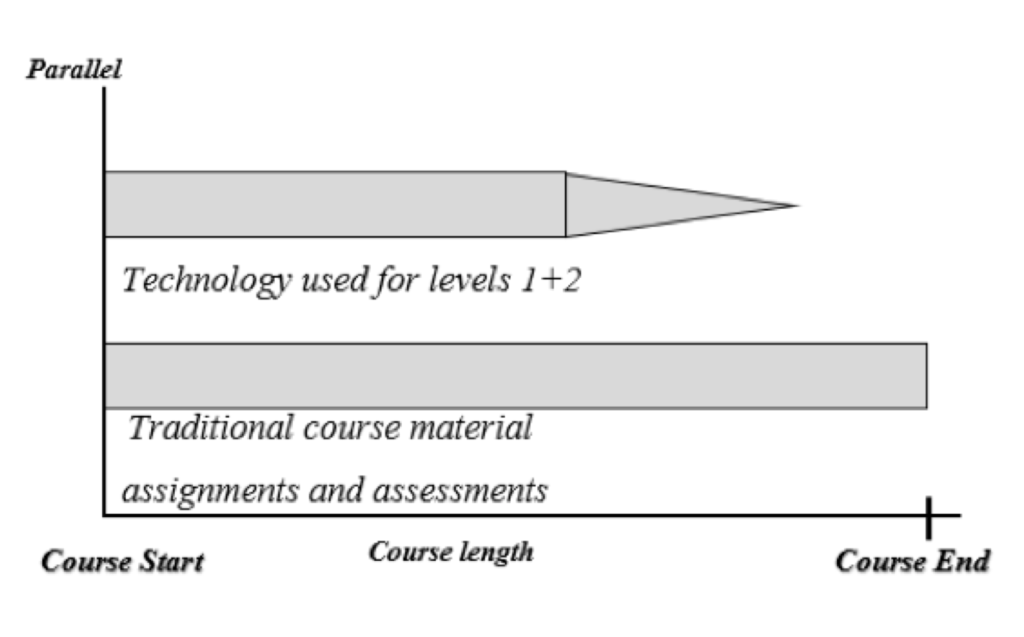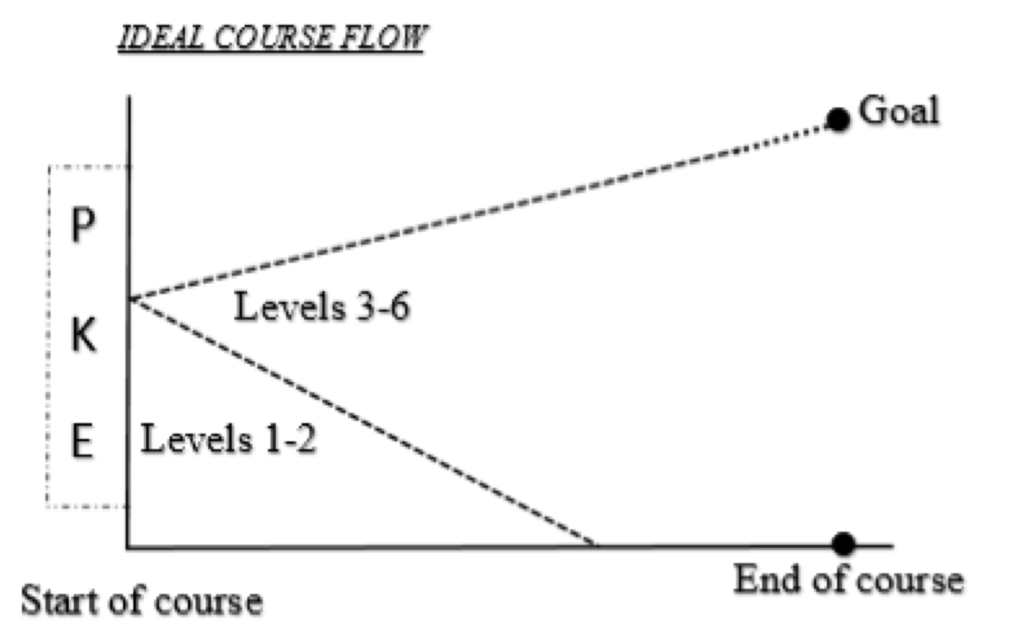Bloom’s Taxonomy: Past, Present, and Future from Theory to Practice in Course Development and Curricula
Bloom’s Taxonomy…Past, Present, and Future from Theory to Practice in Course Development and Curricula
By: Dr. Tim Becker
Abstract
Bloom’s Taxonomy originated in the mid 1950’s with a hierarchical (triangle-shaped) structure indicating the “flow” or steps (6 Levels) of learning and was revised to focus more on the cognitive steps of learning in 2001.
While there is broad recognition in education of the value of the Taxonomy, this document seeks to increase its understanding and, in particular, its use by faculty and instructional designers in the development of courses. The proposed pentagon-shaped model of Bloom’s Taxonomy reflects not only the 6 Learning Levels, but also the type and volume of learning activities and assessments that should be included in courses that are more student and employer-centered. In particular, while courses should be built with learning, knowing and doing throughout in mind, heavier focus on the middle levels (3-5) of Bloom (applying, analyzing and evaluating) should be the focus.
This proposed “update” of Bloom, “Transformed Bloom’s Taxonomy” (TBT), ends with a discussion of how technology may be incorporated in Levels 1 & 2 of courses that revises course structure and delivery and may ultimately increase effectiveness and higher retention of course content.
Introduction
Not many in higher education are unfamiliar with Bloom’s Taxonomy (BT) of 1956 and the familiar pyramid representing the steps of learning and the increased complexity of the process. Over time the use of the original theory by academics in universities and colleges expanded from theory into various application stages of education and programs. The use of BT went from theory to the six learning levels, 1 to 6 in order (remembering, understanding, applying, analyzing, synthesis and evaluation) of the hierarchy. The problem was that while people liked the theory and the suggested activities, it was not picked up by all educators effectively.
As with most theories and their initial use, changes and updates came into play and the same occurred with the original BT. In 2001 the Revised Bloom’s Taxonomy was introduced with a greater focus on learning and retention and switching Levels 5 and 6, synthesis and evaluation went to evaluation and creation. (Wilson, 2006)
The Education Arena Today
The education industry continues to evolve and is in the midst of significant change and is recognizing that change is constant. Whether it is the changes in the expectations of students, the makeup of students and their demographics, the resources available, the delivery modalities, the content itself, everything isn’t what it was five or ten years ago and is not what it will be in the next five or ten years.
Critical recent changes and influences on the future of education include:
- Tuition, fees, housing, and meal costs continued to increase over 30% in last five years. We are often seeing tuition somewhat stabilize or involve slow growth in favor of the number of additional varied fees along with those amounts increasing. Some schools impose student fees approaching 60% of tuition and these fees are for a huge variety of services many of which the individual student will never take advantage of.
- Student enrollment is increasing three to four percent annually
- The number of providers of education by universities and corporations is increasing while we are seeing shut-downs, mergers, and collaborations. In the last 15 months we have seen Corinthian and ITT Tech shut down to the disappointment and dismay of students and faculty. Some innovative providers are coming from outside the traditional industry including Coursera.
- The idea that a college education is of value is a hot topic where everyone has an opinion and their own version of the facts. From most perspectives, a degree is still worth pursuing except where there are huge financial commitments of students which ultimately limits their ability to benefit from the education, economically.
- There is an increasing aggressive effort by universities and colleges to recruit (get) and retain (keep) students for undergraduate programs and to get them to stick around for or come back for advanced degrees.
- Change has also been brought about by the huge growth of onlining courses and programs. No longer is a huge fixed base operation required to educate thousands of students in one location, now it is fairly easy and acceptable to deliver courses online and with remote clusters of students regionally, nationally and around the world.
- Fortunately there is increased interest in change to increase the quality of the education that students get with a focus on content retention. Universities and colleges are recognizing that there is more to education than talking to students and administering tests and there is an increasing focus on learning, knowing, and doing. Employers are increasingly involved in demanding higher quality and higher retention of the content, this is forcing changes to curricula from learning primarily to learning, knowing with a heavy dose of doing…doing the course content in action not just in case studies.
In summary, education is no longer the world of tradition, rather the course content changes constantly, delivery modalities are reaching out to more students and are changing in structure from delivery of huge amounts of content at one time to smaller and more digestible “chunks.” Fortunately, technology enables universities to keep up with the changes and demands.
Considering all the changes of the past, present and projected in the future, education continues to evolve. There is an ongoing challenge to education that is growing in that universities have “limited resources” (money, people, technology, facilities, time, and equipment) to work with, but “unlimited” or countless possible expenses or uses of the resources. Government and private funding for tuition has dropped dangerously forcing students to pay a larger share of their education and this is drastically increasing the debt of students which ultimately restricts their participation in the growth of the economy. A look at the services provided by universities shows that there are huge costs involved to better serve students. There has also been an increase in regulations that universities and colleges have to work with which add to the bureaucracy and costs, things such as Title IX, Diversity and Inclusion, and Disability Services to name a few.
Today, there is more content available that needs to be taught to more students, and an increase in employer demand for college educated employees. This increase in demand for such skilled employees has resulted from increased automation of basic, highly-repeated tasks and jobs formerly done by people along with increased globalization of jobs.
Often traditional educators resist the required changes, but there is no going back. The challenge of changes is that they are faster, there are more changes, and they are more unique than in the past.
Overview of Bloom’s Taxonomies — Original and Revised
Before looking at Bloom’s Taxonomy it is important to look at the framework or environment in which it was and will be implemented. As with any theory and its practice there are some basics that complement it, this is the case with updating Bloom’s Taxonomy. First, students or learners need to want to learn, know, and do the course, they should want to achieve the end result of having gone through the course successfully, ultimately they will see and seek the benefits of completing the course. Secondly, teachers understand the levels and purpose of Bloom’s Taxonomy with the students and learners in mind and create and adapt their courses and delivery with a high degree of flexibility. The Bloom course design flexibility involves regularly identifying where students are in terms of what level of knowledge they have gained from the course and adapt as much of the rest of the course to get most if not all students into the higher(est) level of learning of the content. Third, this requires identification and adaptation by the teacher to identify what prior knowledge and experience a student or learner comes into the course with and from what base he or she is working from.
Memorization fits in Bloom’s Taxonomies (lower Levels 1 & 2), regardless of the version of Bloom. Through memorization the student and learner gets the fundamentals, steps, techniques, processes, dates, amounts, places, and people covered by the content. These items need to be known “cold” in order to be called on and referred to in order to use and act on at the higher levels of Bloom and do so quickly. Having these concepts “in mind” and not having to be referred to or searched at-need for speeds work and doing things with increased productivity. Ultimately, the more that is known “cold” the better, when tasks and processes from the higher levels are done correctly and repeatedly they become auto-memorized and thus stockpiled in one’s mind for future use.
In summary, memorization should not be the primary focus of a class, rather it should initially be a step to acquire the basics of the subject being studied and be a preparation for future use in higher levels of learning and work. (http://education.cu-portland.edu) Frequent and repeated use of memorized items will move them from short term to long term memory which ensures quick access and recall. (Johnson, 2010) Over time, students will find what material needs to be retained for future use and other material that will be tolerable to be forgotten or ignored. In questioning the value or purpose of memorization students and faculty should ask what information in a lesson or chapter or lecture does not need to be memorized or learned and known. The information that is to be memorized should be usable or immediately accessible for use at higher levels or not taught. (Snider, 2011)
Ultimately, while the debate continues about memorization, more questions surface, in particular, “what percentage of what the student learned in a class is OK to forget?” (Beran, Today, approximately 80% of course material that was learned is forgotten in 30 days (65% in 24 hours) and that amount is from what they learned which is much less than what they were exposed to. (Ebbinghaus) This reality reinforces the need to memorize and to use in related higher level activities.
Original Bloom’s Taxonomy Detailed
Sixty years ago Dr. Benjamin S. Bloom and associates put together the hierarchical version of cognitive learning with a foundation of memorization at the lower levels (1&2) with higher complex learning (levels 3-6) based on the memorized content. You could say the more that material is memorized and captured for good provides the student learner with more tools and resources for use in the future where the use of the content is more valued not just the memorized items.
The original Bloom’s Taxonomy from 1956 is based on the hierarchy and flow of learning by learners. (Hummel, 2010) The hierarchy starts with a base of remembering followed by understanding of the course content. Lower level learning (remember and comprehension) is considered to be the core of the course that typically does not vary and everyone that is learning the content must know the material and they start at this point when they use the content. This material is best learned “cold” for quick recall and access to use when needed. These two Levels of Bloom are considered “lower” Levels.
- Remember (Level 1) – here the student learner is exposed to new data that hopefully is converted to information for comprehension. This material to remember includes the fundamentals or tools of the concepts being taught. It is the core of the subject, the basics, the dates, people, places, steps, formulas, locations, and rules that are the core and that which will be used extensively when working the concept. Poor retention of the contents will limit future expertise at higher levels. At this level the student lists, recites, defines, names, identifies, recognizes.
- Comprehension (Level 2) – here is where the student understands what he/she was exposed to in Level 1, knowledge and can make sense out of it and can categorize the new information with other earlier acquired information. This is where the student learner will be able to explain the information and its validity. The student describes, restates, explains, summarizes, and interprets at this Level.
- Application (Level 3) – this is the first go at using the recently acquired and comprehended information. Here also is where the student learner may solve fairly easy unknown problems, this is a real confidence builder for students. The student calculates, predicts, solves, uses, demonstrates.
- Analysis (Level 4) – here is where students may look at the past and put their thoughts together with new information and come up with decisions and suggested actions. Here the student classifies, outlines, breaks down, diagrams.
- Synthesis (Level 5) – this is the first time when students use creativity and deal with unknown situations, they will also use their experiences from prior application and analysis. The student designs, formulates, builds, invents, creates, modifies.
- Evaluation (Level 6) – use of known information and the culmination of repeated and occasional judgment and critiques of situations and other experiences. At this stage, the student chooses, supports, defends, compares, argues, justifies.
“Higher” Levels of Bloom (Levels 3-6) include learning involving applying, analyzing, evaluating and synthesizing the content. It is believed that the higher on the hierarchy the more complex the learning is. (Collins, 2014) Higher levels of learning involve primarily “doing” of the course material with more variables of the content on a situation by situation basis.
An instructor that gets students (learners) to the higher levels with a firm foundation at Levels 1 & 2 is on the path of converting them from simply memorizers to learners and thinkers. (Hummel).
Revised Bloom’s Taxonomy
The “original” Bloom served as the foundation for “Revised” Bloom (RBT). Those Levels and understandings served educators well and got them thinking more about learning and retention, this lead to changes and enhancements to a revised version of Bloom’s Taxonomy.
http://creativeeducator.tech4learning.com/v02/articles/The_New_Blooms
Revised Bloom stresses learning, knowing, and doing in teaching via Bloom and also becomes more active for students, so it is not just Remember, Comprehension, and Application of Levels 1-3, it is Remembering, Understanding, and Applying.
Teachers may not be clear what types of activities and assessments would be appropriate at the various levels of RBT. The following is a list of what are possible and suggested, all geared to get students to learn more quickly and thoroughly with increased doing of the content:
- Revised Bloom’s Levels and Skills or Requirements at Each Level are:
- Remembering – recognizing, listing, retrieving, naming, finding
- Understanding – explaining ideas, interpreting, paraphrasing
- Applying – implementing, using, executing, using information
- Analyzing – explore understandings, comparing, deconstructing
- Evaluating – justifying a decision, checking, critiquing, judging
- Creating – generating new ideas, designing, planning, inventing.
(Anderson & Krathwohl, 2001)
While going from the “original” Bloom to “revised” Bloom there was an evolution of moving from a focus on what students learn to how they learn and what they have to do to learn. (Fink 2011)
The New Model — Transformed Bloom’s Taxonomy (TBT)
Transformed Bloom’s Taxonomy (TBT) uses “Revised Bloom’s Taxonomy (RBT) and incorporate prior knowledge and experiences (PKE). Based on over 15 years of “Revised” Bloom in action, an even more current version and perspective are proposed which reflect an increase in serving students and better guiding faculty in course design and implementation. Further, the hierarchical triangle is expanded to be a hierarchical pentagon geared to show the volume of learning and activities needed
including readings, activities, and assignments throughout a course and life in general.
In the Transformed Bloom Taxonomy, it is recognized that each learner enters a class with a unique combination of prior knowledge and experiences and these make each learner different which adds to the diversity of the class. Further, learners come with different goals and levels of sought after achievements. It is from this foundation (base) that learners gather new knowledge and experiences in every course. New course material may displace prior knowledge and experience, but it is desirable that the prior knowledge and experience “bucket” gets bigger and bigger over time and over life.
- Prior knowledge (material learned and retained) comes from reading, watching and doing some things earlier in life and schools. Prior knowledge can be gained by seeking it out and learned individually or under the guidance of others as in schools, or corporate training.
- Prior experience (based on things done) may have been gained from home, jobs, training, school, events and interactions. Experiences may be gained through structured activities and others that may be spontaneous, further, these may be gained individually or as part of a group.
PKE is a fluid concept in that whatever is “prior” may be updated with new knowledge and or experiences thus eliminating obsolete items and bringing in new items for future use. The changes in PKE may be updates, deletions and additions. Repeated experiences or exposure to prior knowledge are not bad in that they reinforce the correctness and value of those experiences and knowledge. Over life, PKE may get larger for easy reference, recall, and use. The acquisition of knowledge and experiences should be ongoing in and out of education and trainings.
Students and learners approach a class with a personal history of prior knowledge gained from education and other settings and experiences. This knowledge is what is remembered and understood from prior formal education, informal personal learning and includes what was learned from prior experiences. These experiences may be life events or the results of following what some people have taught or suggested to a learner and since good results came around this learning was put in long term memory and thus is available for future use and updating for that matter. So in this case, all this learning that is retrievable comes from learning “cold” that material which is worth holding on to for future use. PKE should be updated on an ongoing basis with some items being deleted and reinforced. One of the unwritten guides when considering PKE is that “bucket” should be as large as possible and it should grow over time through knowledge acquisition and a high degree of experiences. This PKE “bucket” is the foundation of learning as well as knowing and doing.
Transformed Bloom Taxonomy with Pre-Need and At-Need Learning
Businesses (and education) are operating faster, employees are required to operate faster, thus they have to learn and know more material on a pre-need basis in anticipation of using it in the future. Employees cannot just rely on at-need searching for basics and other information when needed, they have to know some of it already. Pre-need knowledge comes from earlier classes and general learning. Learning is not an “either or” situation, it is really some of both and that is the same with gathering information, it is important to anticipate future needs of information and gather as much as possible before the urgency. At-need learning is what is not known via pre-need and has to be gathered with urgency. Once a need arises, it is then just a matter to seek and add information specifically needed and add that to information already acquired on a pre-need basis. The need for more pre-need learning is based around the urgency, immediacy and speed of today’s work tasks and required decision making. The overall intent is to increase pre-need learning and decrease at-need learning.
What to Learn By Transformed Bloom’s Taxonomy and Its Educational Value?
It is critical for educators to focus at the higher levels of Bloom’s Taxonomy when teaching since part of the teacher’s role is to prepare students for the future and the future use of the concepts being taught. According to an AAC&U (Association of American Colleges and Universities) study, civic and business leaders indicated that learning at colleges and universities needs to include more subjects such as information literacy, teamwork and problem solving abilities, intercultural knowledge and competence, ethical reasoning, integrative learning and lifelong learning. Students, leaders and education providers are expected to focus on increasing these skills. (Fink 2011)
The primary study being “Raising the Bar” conducted for the Lumina Foundation in 2009-2010. “Raising the Bar” was a study of executives of companies around the country asking what they felt universities and colleges needed to do better in preparing students. The results indicated that businesses and executives believe that universities need to do better in the following list:
Things to Improve |
percentageAgreeing |
| 1- The ability to effectively communicate orally and in writing |
89%
|
| 2- Critical thinking and analytical reasoning skills |
81
|
| 3- The ability to apply knowledge and skills to real-world settings through internships or other hands-on experiences |
79
|
| 4- The ability to analyze and solve complex problems |
75
|
| 5- The ability to connect choices and actions to ethical decisions |
75
|
| 6- Teamwork skills and the ability to collaborate with others in diverse group settings |
71
|
| 7- The ability to innovate and be creative |
70
|
| 8- Concepts and new developments in science and technology |
70
|
| 9- The ability to locate, organize, and evaluate multi-site information |
68
|
| 10 The ability to understand the global context of situation, decisions |
67
|
(LUMINA, 2010)
Similar findings came from a recent, July 2016, Business Communication class at Southern Oregon University assignment where students researched executives and owners of companies in northern California, Oregon and Washington. These executives were asked what they thought the top 10 skills and traits are and what they expected and sought from recent graduates and new employees seeking a job. The results showed again that higher level skills sought include:
Skills and Traits Employers Look For |
Percentage Agreeming |
| Communication and interpersonal skills (primarily non-verbal, oral and physical) |
50%
|
| Being a team-player |
45
|
| Computer and technological expertise |
42
|
| Ambition |
25
|
| Problem solving skills |
23
|
| Ability to write well (primarily grammar, punctuation, usage, spelling) |
22
|
| Honesty |
20
|
| Organization skills |
20
|
| Adaptability |
17
|
(Becker and Bouwer, 2016)
Based on these examples of research and what was found to be expected of universities, students, and new employees the Transformed Bloom Taxonomy is a good fit. The following is a look at the theoretical view of the new Transformed Bloom Taxonomy considering course development where the foundation made up of prior knowledge and experiences is the starting point for all courses and where new knowledge begins to be learned and practiced over the life of the course. The full revised Bloom is on top of PKE and will be achieved over time including the higher levels. The problem here is that there is less done at the lower levels and much more is done at the higher levels.
Start of the Course |
Up to First half of the Course |
Figure 6-
At these stages developers or instructors put emphasis where it should be, there is a good foundation from PKE in the Lower Levels and then more time, effort, assignments and assessments are piled higher and higher and out more broadly. This enables teachers to spend more of their time in Levels of Applying, Analyzing, Evaluating and Creating, this shift is better for students as they are being better prepared for the work environment and they ultimately better learn, know, and do the subject material. Employers will be pleased with this result where learners come out better prepared.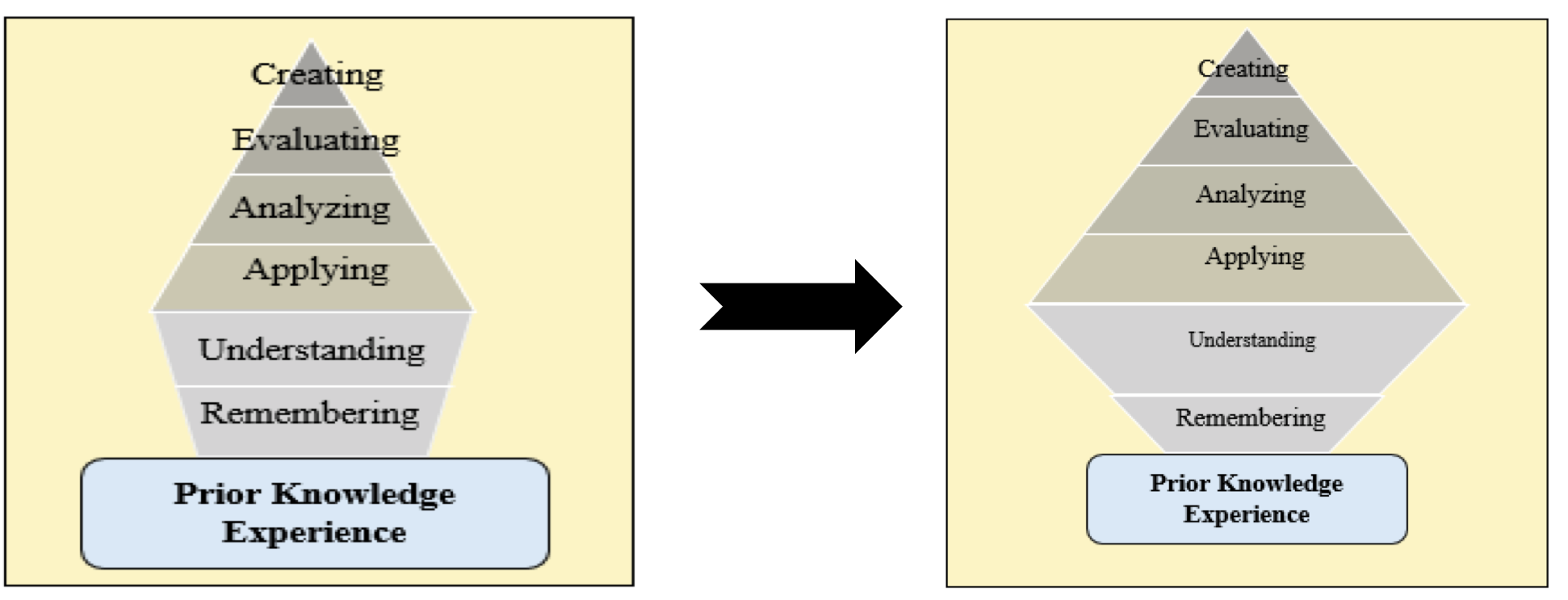
Figure 7- Expansion of the Course and Sought after Knowledge, Skills, and Experiences
This Transformed Bloom Taxonomy shows that it is hoped that the pentagon gets bigger and bigger over the life of a course. More of all stages are learned and done, this also is accommodated by the growth of PKE. (http://www.teachthought.com, September 2015) In a course and at work or in life in general, a student learner will or can draw on PKE before doing anything at the higher level, draw on that expertise and results that are worth emulating again.
Figure 8- Growth of Prior Knowledge and Experiences from a Course
It is worth noting that PKE grows over time with such a development and learning model. The growth of the pentagon and PKE occurs over the life of a course and over a full academic program. Further, they both grow based on learning from life and storing and repeating the positives and ignoring and deleting the negatives.
Figure 9- Time-Lapse of Transformed Bloom Taxonomy
The basic evolution of a Transformed Bloom Taxonomy course:
- A course starts with a unit of PKE and expands over the life of the course.
- Early activities and content are the fundamentals of the course that are the core of any course and is managed by technology
- The starting triangle of the Revised Bloom Taxonomy is small
- The course content goes to higher levels of Bloom
- The amount of the course content and related assessments and assignments expand in volume and frequency moving from the traditional triangle to a pentagon.
Transformed Bloom Taxonomy Implemented
The Transformed Bloom’s Taxonomy is highly and easily used in traditional education especially where the lower two levels are taught and studied by an adapted learning technology tool that guides learners through the process of mastering core material of any course including fundamentals, techniques, steps, dates, people, places, and things. This adaptive learning can be implemented at the start of the course with it being completed satisfactorily by no later than the halfway mark of the course.
Learning via technology covering Levels 1 & 2 of Bloom can also be required to have been mastered before the active and higher level learning is begun and completed through access to and interaction with a professor. Professors would not be involved in the learning of the core except to get a report stating when and that the student achieved the desired mastery and then is allowed into the “doing” (facilitated) stage or higher level of the course. This part of a course is likely to be the latter 60% of a traditional course and is really where the value of the course is to the student today and in the future. Employers and their customers are interested in being sure the employees can actually use formulas, procedures, and do the expected work and are not interested really in employees just being able to spout off definitions or formulas. Parallel traditional teaching and learning with technology covering Levels 1 & 2 of Bloom and the fundamentals of the course material done together.
Through the use of the new Bloom model it is worth noting that there will be better use of faculty time by it focusing on facilitating on the higher levels and not on the lower levels, allowing technology to handle and ensure that. At the same time, facilities may not be used as much or will be used more effectively. Consider a traditional course, roughly 40%+ is spent on Levels 1 & 2 and the time with Transformed Bloom’s Taxonomy to learn can be done at home or remotely with no facilities required. So where a classroom may be occupied for a cohort for 10 weeks, it only needs to be for 6 weeks where there is faculty facilitation. In many cases, even less class time would be required, in this case for example 5 out of 10 class periods. So, as a result, two full courses could be taught in the time and facility used by one traditional course with overall results being far superior and students will be more “attractive” in the employers’ eyes and mind. Ultimately, a university could increase student throughput by 40%+ with no change in required facilities.
Sequential teaching enables the fundamentals of the course to be taught and mastered on an individualized self-paced basis that allows students to learn at their pace with a gamified learning system. Once the content is mastered students then enroll in and participate in the higher level content of the subject that is based almost 100% around “doing” the course subject all based on the very high mastery foundation of the core (Levels 1 & 2) content.
What Comes Next?
Much like the original and revised Bloom Taxonomies, Transformed Bloom is timely and is an excellent response to changes in education, technology, students, and the demands of the marketplace. Transformed Bloom is not an indictment against education, rather it is a recognition that change is needed and that it is a modification to the foundation of learning and not a total re-write of the industry. Change champions are needed throughout education in order to capture the excellence of Transformed Bloom and the positive results.
References
Anderson, L. W., & Krathwohl, D. R. (2001). Revised Bloom’s taxonomy action verbs. Retrieved from www.apu.edu/live_data/files/333/blooms_taxonomy_action_verbs.pdf/.
Becker, T. (2016). The 10 most Important skills employers seek and expect from recent graduates and new employees. James Bouwer.
Beron., M. K. (2004). In defense of memorization. City Journal. Retrieved from http://www.city-journal.org/html/defense-memorization-12803.html/.
Big Dog and Little Dog’s Performance Juxtaposition (2015). Bloom’s taxonomy of learning domains. http://www.nwlink.com/~donclark/hrd/bloom.html
Bloom’s revised Taxonomy Planning Framework. Retrieved from www.niu.edu/facdev/_doc/blooms_planningsheet.doc/.
Churches, A. (2008). Bloom’s digital taxonomy map. Retrieved from http://catcher.sandiego.edu/items/cee/Blooms%20Digital%20Taxonomy.pdf
Collins, R. (2014). Skills for the 21st century: teaching higher-order thinking. Curriculum & Leadership Journal (12) 14. Retrieved from http://www.curriculum.edu.au/leader/teaching_higher_order_thinking,37431.html?issueID=12910
Concordia University (2012). What is rote learning? A battle between memory and intelligence. Retrieved from http://education.cu-portland.edu/blog/curriculum-instruction/what-is-rote-learning/
Creative Educator (NA). Moving up Bloom’s Taxonomy. Retrieved from http://www.thecreativeeducator.com/v02/articles/The_New_Blooms_Taxonomy/.
Green, D. Memory: A contribution to experimental psychology, Hermann Ebbinghaus (1885). Retrieved from http://psychclassics.yorku.ca/Ebbinghaus/index.htm
Higher Education Teaching & Learning Association (2011). Creating significant learning experiences: An HETL interview with Dr. Dee Fink. Retrieved from https://www.hetl.org/significant-learning-experiences/
Hummel, P. (2012). Bloom’s Taxonomy basics. Retrieved from. http://adjunctassistance.com/general-information/blooms-taxonomy-basics
Jabar, S. I., Albion, P. R. (2016). Assessing the reliability of merging Chickering & Gamson’s seven principles for good practice with Merrill’s different levels of instructional strategy (DLISt7). Online Learning, (20) 2. Retrieved from https://olj.onlinelearningconsortium.org/index.php/olj/article/view/784
Johnson, B. (2010). When rote learning makes sense. Edutopia. Retrieved from https://www.edutopia.org/rote-learning-benefits/.
Lumina Foundation (2010). Raising the bar.
Page, B. (2016). 12 things teachers must know about learning . Teachers Net Gazette, (14) 1. Retrieved from http://gazette.teachers.net/gazette/wordpress/bill-page/12-things-teachers-must-know/
Personal Development Training. The Ebbinghaus forgetting curve – And how to overcome it. Retrieved from https://sidsavara.com/the-ebbinghaus-curve-of-forgetting/
Professional & Organizational DevelopmentNetwork in Higher Education. Higher level learning: A taxonomy for identifying different kinds of significant learning, L. Dee Fink. essays on teaching excellence – Toward the best in the academy.Retrived from http://www.asa.mnscu.edu/facultydevelopment/resources/pod/Packet3/higherlevel.htm
Schacter, D. L, (2001). The seven sins of memory: how the mind forgets and remembers. Boston: Houghton Mifflin.
Snider, J. (2011). Rote memorization: Overrated or underrated? Huffington Post Retrieved from http://www.huffingtonpost.com/justin-snider/rote-memorization-testing_b_817170.html
TeachThought Staff (2015). 4 Strategies for teaching with Bloom’s Taxonomy. Retrieved from http://www.teachthought.com/critical-thinking/strategies/using-blooms-taxonomy-21st-century-4-strategies-for-teaching/
Wilson, L. W. (2016). Anderson and Krathwohl – Bloom’s taxonomy revised. The Second Principle. Retrieved from http://thesecondprinciple.com/teaching-essentials/beyond-bloom-cognitive-taxonomy-revised/.
 Dr. Becker is an academic, entrepreneur, and futurist.
Dr. Becker is an academic, entrepreneur, and futurist.
Dr. Becker never stops, he is always thinking, creating, challenging, and enhancing, whether it is in a university classroom, office, or in the business environment.
He has directed over 3,000 employees in an airline’s worldwide customer service operation, co-lead the startup of an airline in Australia, co-founded and developed a patented learning software program and company. In academics, he has taught Business, Management, all facets of Marketing for over 20 years, developed and updated over 20 courses, and was one of 6 faculty tasked with developing the first online competency-based education Bachelor of Arts program. Further, he has authored a book “Challenge Givens,” regularly presents at the annual Lilly Conference of Teaching and Learning.
In Dr. Becker’s many past and ongoing endeavors he is creative, decisive, and supportive. Students and employees of Dr. Becker excel in the fields of study and work and thrive in practical and out-of-the-box settings. Throughout his career he has practiced what his fourth grade teacher encouraged, “don’t be a ‘me-no-can’, be an ‘I-can-do!”
Dr. Becker enjoys sharing reality experiences and lessons with students, audiences, and readers. He continues developing a set of “must-do’s” of business, speaks to employees and employers on marketing, management, strategy, and entrepreneurship. One lesson that’s regularly present in conversations and presentations with Dr. Becker is to stand-out and differentiate yourself which may be easier than you think.
He has traveled to 38 states in USA and 21 countries. Tim is a graduate of Luther College, received an MBA from the University of Dallas, and a DBA from United States International University.
